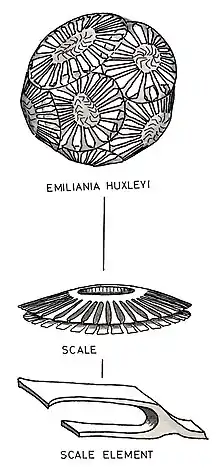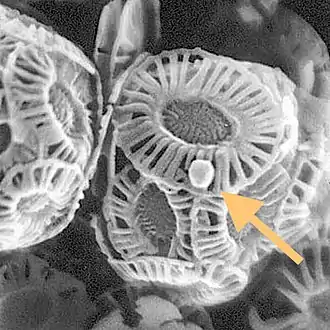Emiliania huxleyi
Emiliania huxleyi ist eine Kalkalge und gehört zur Ordnung der Coccolithophorida. Sie kommt von den Polargebieten bis zum Äquator weltweit vor und ist eine Schlüsselspezies im Ökosystem Ozean. Coccolithophoren wie Emiliania huxleyi halten einen Anteil von beinahe 50 Prozent an der biologischen Kohlenstoffpumpe der Meere und leisten ein Drittel der meeresgebundenen Produktion von Calciumcarbonat.[1]
| Emiliania huxleyi | ||||||||||||
|---|---|---|---|---|---|---|---|---|---|---|---|---|
.png.webp)
Emiliania huxleyi | ||||||||||||
| Systematik | ||||||||||||
| ||||||||||||
| Wissenschaftlicher Name | ||||||||||||
| Emiliania huxleyi | ||||||||||||
| (Lohmann) W.H. Hay & H. Mohler |
Emiliania huxleyi ist ein einzelliges Phytoplankton, bedeckt mit mikroskopischen Calcit-Scheibchen, sogenannten Coccolithen. Benannt nach dem britischen Forscher Thomas Henry Huxley, ist Emiliania huxleyi der weltweit bedeutendste Vertreter der Coccolithophorida.
Emiliania huxleyi wurde aufgrund ihrer klimatologischen Relevanz von der Deutschen Botanischen Gesellschaft zur Alge des Jahres 2009 gewählt.[2]

Algenblüten
Algenblüten von E. huxleyi können enorme Ausmaße erreichen,[3] möglicherweise bis über 100.000 km2.
Parasiten

Emiliania huxleyi wird von Viren der Spezies Emiliania huxleyi virus 86 (EhV-86) aus der Gattung Coccolithovirus parasitiert, einem Riesenviren aus der Familie Phycodnaviridae.[4]
Weblinks
Einzelnachweise
- Iglesias-Rodriguez, M. Debora, Paul R. Halloran, Rosalind E. M. Rickaby et al. (2008): Phytoplankton Calcification in a High-CO2 World, in: Science, Vol. 320, Nr. 5874, S. 336–340, doi:10.1126/science.1154122
- News auf Scinexx.de
- Beauty in the Barents, NASA Earth Observatory, 15. Juli 2021. Dazu:
- Karin Schlott: BARENTSSEE: Wenn die Arktis blaugrün blüht, auf: Spektrum.de — Bild der Woche vom 27. Juli 2021
- Ben A. Wagstaff, Iulia C. Vladu, J. Elaine Barclay, Declan C. Schroeder, Gill Malin, Robert A. Field: Isolation and Characterization of a Double Stranded DNA Megavirus Infecting the Toxin-Producing Haptophyte Prymnesium parvum, in: Viruses 2017, Band 9, Nr. 3, Special Issue Marine Viruses 2016, 40; doi:10.3390/v9030040
